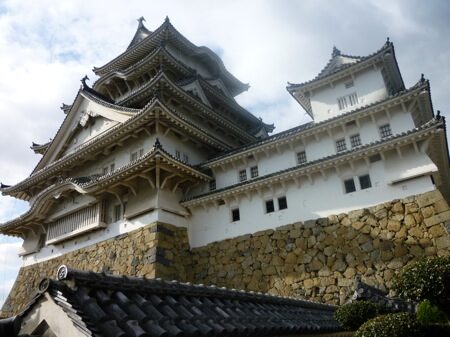Japanese castles are one of the nations’ most popular tourist attractions amongst foreign travelers. Of all the castles in Japan, only 14 remain in original condition, of those, only four are designated as National Treasures, and only one is recognized as a UNESCO World Heritage site. Japan’s first World heritage site, listed along with the Horyu-Ji Temple in 1993, is Shirasagi Castle, also known as Himeji Castle.

Himeji Castles’s main focal point is, without doubt, the splendor of the keeps. The unique five layered, six floored main tower, the Tenshukaku, and the three Kotenshu, Watari-Yagura smaller towers with their intricate gabled roofing design, and white plaster-covered walls are most impressive, installing a sense of awe in all who see it.
If modern-day people can be awed by the scale and beauty of this castle, you can imagine the sense of wonder people felt over 400 years ago. It is a defensive structure, built for the horrors of war, but combines elegant, artistic design, making it one of great beauty.

The original Himeji Castle, established in 1346, was nowhere near as impressive as the castle we see today. It’s current grandeur can be attributed to Toyotomi Hideyoshi (Then known as Hashiba Hideyoshi) who had the fortress completely rebuilt on a much larger scale in 1580, and further enlarged, strengthened and renovated by Ikeda Terumasa during the early Edo Period.
Who helped Hideyoshi procure the stones for the castle?

Japan was in the midst of civil war, and Himeji Castle was to be a base from which Hideyoshi’s struggle to unify the nation began. For that reason, a large, imposing, and impressive castle was required.
An interesting story is that during the construction of the castle, materials were scarce, particularly large stones for the defensive walls. A collection was started when an old woman approached the warlord and offered her millstone saying, “Please use this”.
Delighted by the offer, Hideyoshi ordered the builders to ensure the old woman’s millstone could be seen by all in honor of the woman’s gift. (The photograph on the right shows the millstone brought by the old woman.)
The stone is known as the Uba ga Ishi, or Old Woman Stone, and is believed to protect the castle, bringing good fortune and a long life. The stone was said to have motivated the populace into acquiring more stones for the construction so the splendid castle was soon completed.
The Castle was purchased for just 23 Yen.

Japan’s feudal system collapsed, domains were abolished and many of Japan’s beautiful castles were abandoned, torn down or auctioned off in the early Meiji Period (1868-1912) Himeji Castle was no exception.
Sold at auction for scrap, Himeji castle went for just 23 Yen, 50 Sen, the modern-day equivalent of 240,000 Yen, or about $2,400. The purchaser had intended to sell the roof tiles before realizing the individual tiles were too big and too heavy for standard houses, and that dismantling of the castle for scrap metal and timber was going to be too costly, he eventually renounced his rights to the castle.
Thankfully, that lead to this beautiful castle being adopted by the government and preserved to this day.
007 James Bond and problems at Himeji Castle!

Himeji Castle is often used in filming period dramas and movies. In 1967, the castle was used as a location for the Sean Connery 007 James Bond movie, “You Only Live Twice”.
Himeji castle appeared as a “Secret ninja training camp north of Tokyo”, where James Bond arrived by helicopter to scenes of black-clad ninja conducting fighting practice and throwing shuriken ninja stars. Unfortunately, some of the thrown ninja stars, and an extra with a pole arm weapon called a naginata, made holes in the traditional white plastered walls of the national treasure!
This became a major problem for the studio, who were charged with having to pay for repairs to the whole section of wall.
For a long time after that incident, filming was banned at Himeji Castle, however famed Japanese director Kurosawa Akira shot parts of his 1985 samurai epic “Ran” there, and a few scenes in the 2003 movie, “The Last Samurai” used Himeji Castle as a location.
Current Restoration.

Extensive restoration work on the World Heritage-listed castle commenced in June of 2009, and is expected to be completed on March 18, 2015. For that reason, the castle is currently shrouded in a huge tent like cover. Although the beautiful castle can’t be seen from the outside, limited areas are still open to the public.
English site:http://www.himeji-kanko.jp/en/
English Site:http://www.himejijo-syuri.jp/en/index.html
Address:Himeji City, Hyogo Prefecture, Honmachi 68.
Access: 15 minutes walk, or 5 minutes bus ride from JR Himeji Station

